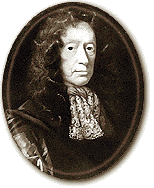

 Edmund Waller was born March 3, 1606
in Coleshill,
Hertfordshire (now in Buckinghamshire), the eldest son of a wealthy
landowner. He was educated at Eton
and King's College,
Cambridge. He was elected to Parliament at the young age of 16, and
became a noted orator, said by John Aubrey to
have possessed "a great mastership of the English Language"1. Edmund Waller was born March 3, 1606
in Coleshill,
Hertfordshire (now in Buckinghamshire), the eldest son of a wealthy
landowner. He was educated at Eton
and King's College,
Cambridge. He was elected to Parliament at the young age of 16, and
became a noted orator, said by John Aubrey to
have possessed "a great mastership of the English Language"1.
On 5 July 1631, Waller married Anne Banks, a
London heiress, but she died after three years of marriage. Waller is
then said to have courted Lady Dorothy Sidney, in the guise of
"Sacharissa", and Lady Sophia Murray, in the guise of "Amoret", both
with no luck. In 1644 Waller married again, a Mary Bracey (or Breaux).
During the troubled 1640s, Waller tried to
maintain a moderate course between the King and his opponents. In 1643
he devised a plot to to oust the Parliamentary rebels, "Roundheads",
and to secure London for the King. When the plot, known as "Waller's
Plot", was discovered in May, Waller was arrested and brought before
the Parliament. Waller confessed and pleaded for mercy, but his freedom
lay in bribes and betrayal of his co-conspirators—Waller was fined
heavily (£10,000) and exiled. Waller lived in Paris, travelling
occasionally in Italy and Switzerland, until 1652 when he was allowed
to return. He returned to Parliament and was returned to royal favor at
the Restoration.
Waller died in his bed, aged 82, 21 October 1687.
Waller was a celebrated poet and wit in his
lifetime, and many of his poems had long circulated in manuscript
before the 1645 publication of his Poems. The first fully
authorized edition was that of 1664. In 1655 appeared the "Panegyrick to my
Lord Protector", celebrating Cromwell, and
in 1660 "To
the King, Upon His Majesty's Happy Return", celebrating the
restoration of King Charles II.
To Samuel Johnson
this writing of panegyrics to both Cromwell and Charles evinced moral
vacuity. Upon Charles' observation that Cromwell's was the better poem,
Waller supposedly answered: "Sir, we poets never succeed so well in
writing truth as in fiction."1
Waller's later works include Divine Poems (1685) and The
Second Part of Mr. Waller's Poems, posthumously published in 1690.
Waller, a member of the Royal Society,
brought refinement to the heroic couplet,
which led to the symmetrical patterning of the Augustan heroic
couplet. It is no surprise that Waller's poetry was highly esteemed in
the eighteenth century. Dryden wrote
that Waller "first made writing easily an art." Alexander Pope
acknowledged Waller as a master, and the Biographia Britannica
(1766) called him "the most celebrated lyric poet that ever England
produced."1 Waller's reputation and
readership has since steadily declined, and he is known today mostly
for his lyrics "Go,
Lovely Rose", and "On a
Girdle."
- The
Cambridge Guide to Literature in English. Ian Ousby, Ed.
Cambridge, Cambridge University Press, 1998.
Primary and Secondary Sources for Study
:
Allison, A. W. Toward an
Augustan Poetic, 1962.
Chambers, A. B. Andrew
Marvell and Edmund Waller, 1991
Chernaik, Warren L. The poetry of limitation, a study of Edmund
Waller, 1968.
Gilbert, Jack Glenn. Edmund Waller, 1979.
Waller, Edmund. Poems.
George Thorn Drury, Ed., 1893


Waller | Life
| Works | Links
| Essays
|
17th C.
Eng. Lit.

Site copyright © 1996-2010 Anniina
Jokinen. All Rights Reserved.
Created by Anniina Jokinen
on February 8, 2000. Last updated on March 3, 2010.
Background by Anniina Jokinen from a tile by Stormi.
Created with the kind permission of Stormi
Wallpaper Boutique.
|
